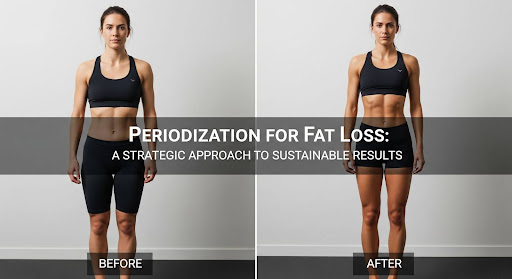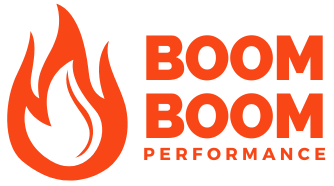
Achieving sustainable fat loss isn’t about drastic, one-size-fits-all diets. It’s about crafting a personalized strategy that balances hard work with recovery, and this is where periodization for fat loss comes into play. By breaking your fat loss journey into structured phases, you can prevent plateaus, preserve muscle mass, and optimize fat-burning without burning out.
What is Periodization for Fat Loss?
Periodization is the practice of strategically structuring your fitness and nutrition over time to promote fat loss in phases. Each phase has a specific focus, such as preparation, active fat loss, and transitioning to maintenance. This approach is designed to keep your body responding to training and dieting while ensuring long-term success and preventing the all-too-familiar dieting burnout.

Why Periodization Works: The Key Benefits
Periodization for fat loss offers several benefits, making it an effective strategy for sustainable fat loss:
-
Reduces Diet Fatigue and Burnout
Constant dieting can be mentally and physically draining. Periodization incorporates planned recovery periods or “maintenance” phases, which help reduce the stress of continuous calorie cutting and keep the process manageable. This approach helps maintain motivation over the long haul.
-
aMinimizes Metabolic Adaptation
Prolonged calorie restriction can lead to metabolic slowdown, making fat loss increasingly difficult. By incorporating diet breaks or refeed days, periodization helps prevent metabolic adaptation, keeping your metabolism responsive to changes in diet and exercise.
-
Helps Retain Muscle Mass
Fat loss isn’t just about shedding pounds; it’s also about maintaining lean muscle. During a calorie deficit, the body may turn to muscle tissue for energy, but periodization, especially when combined with strength training and sufficient protein intake, ensures muscle preservation. This is key to maintaining a healthy metabolism.
-
Boosts Long-Term Success
By cycling through various phases, periodization helps you build sustainable habits that are easier to maintain. This avoids the yo-yo effect that many people experience after a crash diet. The structured approach to fat loss also reduces the risk of regaining lost fat after the diet ends.
-
Improves Mental and Physical Readiness
The planned recovery phases in periodization contribute to a healthier relationship with food and your body. Taking breaks from a calorie deficit reduces stress, enhances overall well-being, and keeps you mentally prepared for the challenges of long-term fat loss.

Key Phases in a Periodized Fat Loss Plan
While the specifics of periodization can vary, most plans follow a three-phase approach: Primer, Progressive, and Prosper. Each phase serves a specific purpose in the fat loss journey.
-
Phase 1: Primer (Preparation)
The primer phase is all about getting your body ready for fat loss. It focuses on optimizing biofeedback such as sleep, stress levels, and digestion. You’ll also focus on improving diet quality by eating more whole foods, increasing fiber, and balancing macros. By stabilizing metabolism and hormone levels, this phase sets you up for success in the next stage.
-
Phase 2: Progressive (Active Fat Loss)
The second phase is the active fat loss phase, where the focus shifts to creating and managing a calorie deficit. This is when you’ll focus on personalized nutrition plans with the right calorie and macronutrient targets. Additionally, this phase involves monitoring progress by tracking weight, measurements, and performance. You might also incorporate refeed days or diet breaks to help you push through plateaus and keep your metabolism responsive.
-
Phase 3: Prosper (Post-Diet Transition and Maintenance)
After sustained fat loss, it’s crucial to transition out of the calorie deficit and establish sustainable habits. The Prosper phase is about gradually increasing calorie intake to stabilize your metabolism. It’s also about shifting from strict tracking to more mindful, intuitive eating. This phase focuses on maintaining high protein intake, daily movement, and consistent training while setting new goals for physique, performance, or overall health.
How to Train During a Periodized Fat Loss Plan
Your training plan should complement the phases of your nutrition periodization. Strength training and cardiovascular exercises are both essential components of a well-rounded fat loss strategy.
-
Strength Training
Strength training is key for building and maintaining muscle, which helps boost metabolism and improve body composition. Aim for at least three strength training sessions per week, targeting different muscle groups each time.
-
Cardiovascular Exercise
Cardio is crucial for creating a calorie deficit and improving heart health. Including HIIT or aerobic training on alternate days will further boost fat burning while preserving lean muscle mass. A combination of strength training and cardio is the most effective way to optimize fat loss.
-
Combining Strength and Cardio
Together, strength training and cardio accelerate fat burning, preserve muscle, and enhance overall metabolism. A typical week might include strength sessions alongside 20–30 minutes of cardio (HIIT or moderate-intensity) on alternate days.
Frequently Asked Questions
1. How long should each phase of periodization last for fat loss?
Each phase of periodization typically lasts between 4 to 6 weeks, depending on your progress and goals. It’s essential not to rush the process, giving your body time to adjust and adapt.
2. Can I use periodization if I have a lot of weight to lose?
Yes! Periodization works for individuals with significant weight loss goals. It helps preserve muscle mass while facilitating fat loss, making the process more sustainable and effective.
3. Do I need a coach to implement periodization for fat loss?
While it’s possible to implement periodization on your own, a coach or fitness professional can help tailor your plan to your specific needs. A coach can track your progress, adjust your plan as needed, and ensure you’re staying on the right track.
4. Can I incorporate periodization into my existing workout routine?
Absolutely! You can modify your current workout routine to fit into a periodized approach. By structuring your nutrition and training into phases, you can continue your regular workouts while benefiting from the strategy of periodization.
Periodization is the Key to Long-Term Fat Loss Success
Incorporating periodization for fat loss into your routine isn’t just about losing weight—it’s about doing so in a way that’s sustainable, healthy, and efficient. By cycling through phases of preparation, active fat loss, and maintenance, you can avoid the typical pitfalls of traditional dieting, such as plateaus and burnout. Periodization allows you to focus on both physical and mental readiness, ensuring that you’re not only achieving your fat loss goals but also building a foundation for long-term health and fitness.
If you’re ready to take your fat loss journey to the next level, consider a periodized approach. It’s a strategy that aligns with your body’s natural rhythms and keeps you motivated, energized, and on track to achieve lasting results.


